Spider-view: The Infinity Crusade
Jim Starlin's cosmic trilogy wraps up Warlock's ongoing story adequately, even if several other characters feel wasted across hollow pages
—by Nathan on August 27, 2025—
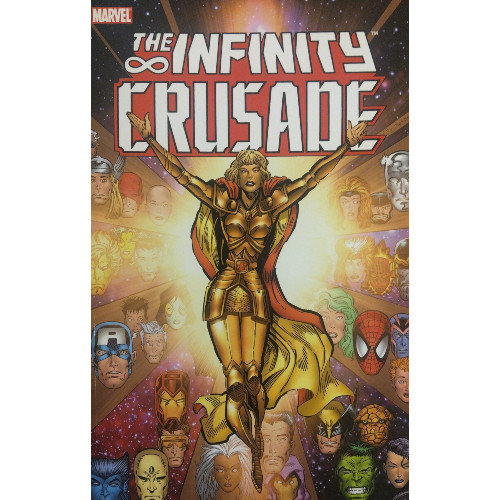
When Adam Warlock took possession of the Infinity Gauntlet following the defeat of Thanos the Mad Titan in Jim Starlin's celebrated limited series, he divested himself of his righteous and villainous halves, believing a neutral state would benefit him and allow him to properly, unselfishly wield the Gauntlet.
That didn't quite work the way Adam wanted it to.
Adam's evil side manifested itself as the Magus, who reigned terror down on Marvel's merry heroes in the form of twisted doppelgangers as he plotted to assume control of the universe itself. Once defeated (for a second time), the Magus was banished to the Soul World inhabiting the Infinity Gem Warlock wore…
…but still not was all well with the universe.
At the end of Infinity War, Thanos posited that, even with Warlock's dark side defeated, the universe would most likely have to contend with his good (let's say "better") half in the near future. Infinity Crusade, the third and final crossover epic in Jim Starlin's trilogy, makes that threat tangible. The Goddess has come to save the universe from itself…but her idea of "saving" may clash with how your traditional superheroes may imagine the process going.
The Infinity Crusade
Writer: Jim Starlin
Pencilers: Ron Lim, Tom Raney, Angel Medina, Tom Grindberg, and Kris Renkewitz
Inkers: Al Milgrom, Keith Williams, and Bob Almond
Colorists: Ian Laughlin, Gina Going, Renee Witterstatter, Tom Vincent, and Mike Kenny
Letterer: Jack Morelli
Issues: Infinity Crusade #1-6, Warlock Chronicles #1-5, and Warlock and Infinity Watch #18-22
Publication Dates: April 1993-November 1993
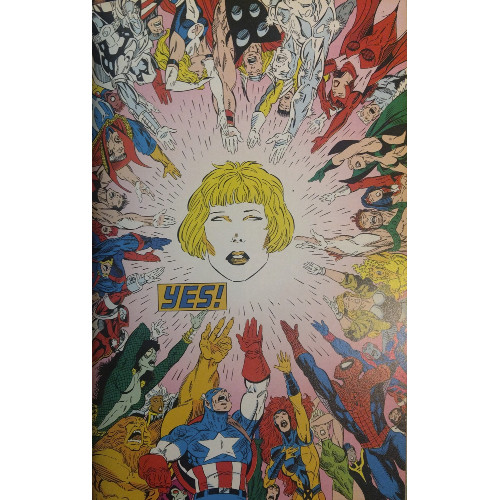
I closed the final page of Infinity Crusade–initially collected by Marvel, perhaps because of scope, in two trade paperbacks–with a lot of thoughts, a whole buncha takes on this tale just ping-ponging around my brain. So let's start with that "scope" idea: to fully understand Crusade, you'll need to read not just the six-issue limited series but several issues of Warlock and the Infinity Watch as well as the first five issues of an eight-issue Warlock-centric limited series. There are, naturally, a host of tie-ins across the Marvel Universe you could read as well, collected in omnibus format, but I let myself be happy with just the main narrative itself. I will say this: unlike other crossover narratives I have read (including some published by Marvel's Distinguished Competition), I never felt like I needed to read individual issues starring Spider-Man, Moon Knight, Doctor Strange, or the Silver Surfer to grasp the full story, so kudos to Starlin for making the six-issue limited series feel complete on its own.
But though the story feels complete without the tie-ins, the additional Warlock Chronicles and Infinity Watch issues (the latter of which are available in other formats, including the team's own first collection) stretch aspects of the series unnecessarily. There are elements, particularly those dealing with Warlock's character, which are important to Crusade's overarching story and are arguably even crucial. What happens, unfortunately, is that packing those issues between the individual chapters of the main Crusade installments lengthens a story which already cannot fully justify its entire page count.
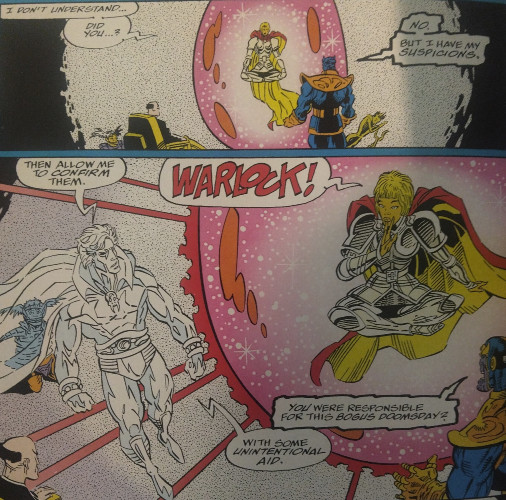
One of the reasons the original Infinity Gauntlet works so well is that it's a tale divided neat in half, the first dealing with the ramifications of Thanos' "SNAP!" and the assembling of Marvel's finest heroes, the second showing the assault on Thanos' home base and the efforts made to relieve him of the Gauntlet. The story is clean and concise, and though it had tie-ins of its own, you did not need to read those to appreciate the series. We get character introductions and some exposition as Starlin and George Perez explore the devastation caused by Thanos' machinations, followed by action on a cosmic scale when our heroes confront the Mad Titan.
Crusade cannot boast such handling. Where Gauntlet's first conflict occurs at the halfway part, readers of Crusade are not treated to an intense brouhaha until the series' fifth issue, having also read four issues of Warlock Chronicles and five issues of Infinity Watch by that point, if you're reading the collected editions. Sure, fans reading the individual issues need only tackle the first four chapters of Crusade before reaching a climactic confrontation, but for the collected edition reader, you're thirteen issues deep into a sixteen-issue arc before the dramatic showdown Starlin took three issues to build towards in Gauntlet.
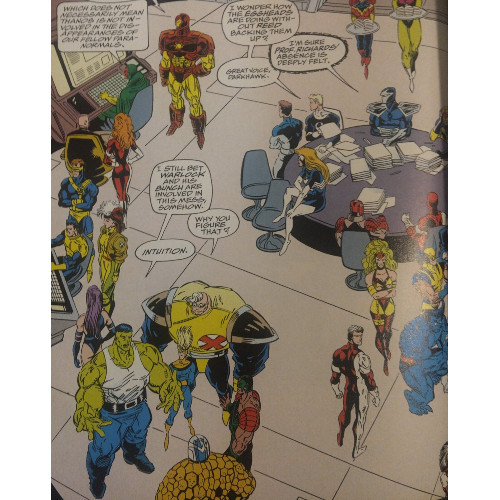
This means Starlin and his artists have a lot of room to work with, in not just the preceding Crusade issues but also the Warlock and Infinity Watch chapters. To his credit, Starlin is endeavoring to make sure he doesn't tread old ground, a difficult task as he's dealing with a cosmic adversary spinning out of Warlock, the same golden-hued hero the Magus was drawn from in War. Starlin maneuvers around this by drawing on concepts of faith, bringing in several superheroes to fight for the Goddess as she plans to save the universe from its sins through a cosmic cleansing. Our heroes are brainwashed, removing some of their agency, but Starlin does credit their religious beliefs and/or leanings, something I feel would generally be swept under the rug or not discussed.
Some of Starlin's choices for these heroes are obvious–the Catholic Matt Murdock is approached, as is actual deity Thor and the morally upright Captain America–and some are a bit bizarre. Susan Storm is selected for her "little-spoken-of-faith," a decision I feel Starlin cooked up on the spot, while oddly ignoring her teammate Ben Grimm's Jewish background (likewise for Kitty Pryde). What this does allow Starlin to do is create conflict between the "believer" characters and the "non-believer" characters, and while some may turn their noses up at the brainwashing bit, I feel it does prevent him from having to force confrontation between these characters.
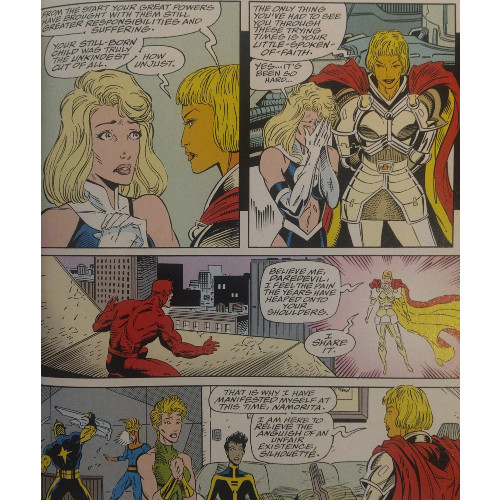
I do wish Starlin had explored the idea of faith in some more depth. It plays a massive role in the series' plot, the Goddess spouting off all manner of religiously tinged dialogue as she prepares for her "crusade." Her brainwashed supporters feel fanatical, as if belonging to a cult, and though some argument is made early on among the remaining heroes as to how morality and religion play into the Goddess' decision, it doesn't strike to the core of the series as strongly as it could. Perhaps Starlin just wanted to remain vague, playing it safe so as not to alienate portions of his readership. I felt he could have leaned a tad more heavily into the idea, or at least explored the ramifications of these characters being taken and brainwashed precisely because of what they believe. I'd argue his original work on Warlock handled such material in a more interesting fashion.
What it does allow for the rest of our heroes are stretches of plotting and planning, of discussing the exact threat the Goddess poses…if she poses a threat at all? Starlin capably creates in the Goddess an engaging balance between villain and possible savior. She identifies the problems with reality accurately…does she possess the right solution? That internal conflict bubbling within our heroes–are they really in the right to face her?–is perhaps intended to balance out the lack of physical conflict presented later in the series. Starlin appears to be playing a more cerebral game with this narrative, replacing physicality with philosophy.
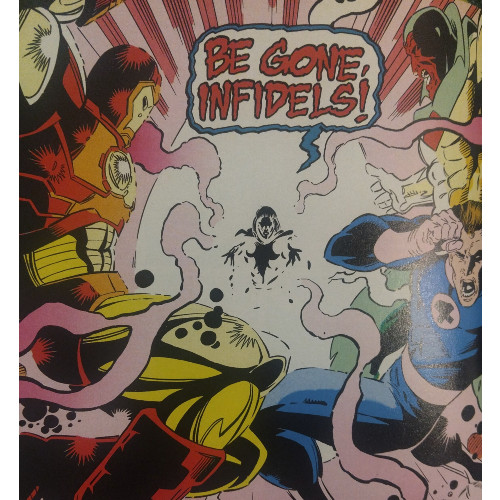
The greatest issue is that the build up takes so long that the effort becomes diffused across the chapters. You can only hear brainwashed superheroes call each other "Brother" and "Sister" or hear the Goddess talk about cleansing a tainted cosmos so often before you start wishing she'd just get on with the plan. The included tie-in issues endeavor to develop certain subplots to engage the reader and left me feeling divided– tipping the scale downward, Pip the Troll becomes a bizarre "secondary antagonist," his role far outstripping my interest in him, and a deal between Thanos, Warlock, and Mephisto casts the demon in an intriguing middle man role but does little with his character; seeking to restore balance, the mysterious Infinity Watch member Maxam pulls his weight, becoming a standout character who comes with interesting questions I hope Starlin explored in future stories. My assumption is Starlin struggled to craft a story adequately filling six chapters, let alone ten tie-in issues, and stretched himself to find material to tell all the pieces of this tale.
When he isn't devoting himself to subplots, Starlin is filling the space between plot developments with Warlock's own ongoing story, which really has been the crux of Starlin's "Infinity Trilogy." He's the star, in all his glowing, golden glory, and we should be invested in him the most as a character. Starlin gives Warlock nothing less than his full attention, wrapping his own internal conflict into the chapters of not just Crusade but also the issues of the two included tie-in series which bear his name. Warlock, as in other stories, is tasked with facing a struggle with identity, and the idea that Starlin has been building since the ending of Gauntlet–that, perhaps, removing his good and evil sides to embrace a moral neutrality was not the wisest decision–comes to a head here. Is that neutrality something Warlock will need to sacrifice in order to stop the Goddess?

Warlock's tale becomes the most interesting development in this series, primarily out of necessity, though not without one hurdle: despite my appreciation of Warlock in this crossover, I found him too overwhelming at points. In Gauntlet, Warlock was the man who pulled the strings, who maneuvered our heroes into position. Here, he employs a level of subterfuge to struggle against the Goddess, and though I believe giving him such a significant role was wise and represented a good "conclusion" to his encompassing story in this "trilogy," Starlin maintaining Warlock's scheming, know-it-all strategy renders other characters moot. I wished Warlock had been front-and-center, less cagey. His own tale is important, offering him an opportunity to find fulfillment and wholeness he hasn't been allowed since the 70s, but for the grander story, he acts as a kind of deus ex machina when he should be leading the charge.
Yes, moments exist for our heroes to excel. The Silver Surfer, absorbing energy from the Sun and turning temporarily bulky and crimson in a nifty illustration from Ron Lim, annihilates an entire planet like a flaming meteor. Thor and Drax are given the bulk of an issue to go mano-a-mano, Drax's brutality set up against Thor's own bloodlust, a condition of "berserker rage" he experienced at the time. Heck, the Mole Man of all people, though not a hero, serves as an ally of the Infinity Watch and makes fools out of U.N.-sanctioned military forces in a scene which, while not important to the overarching plot, is unexpected and entertaining. Even amidst the cosmic powers crashing, subplots bouncing hither and yon, and scattered, shallow references to belief systems, fun can still be found in the panels.
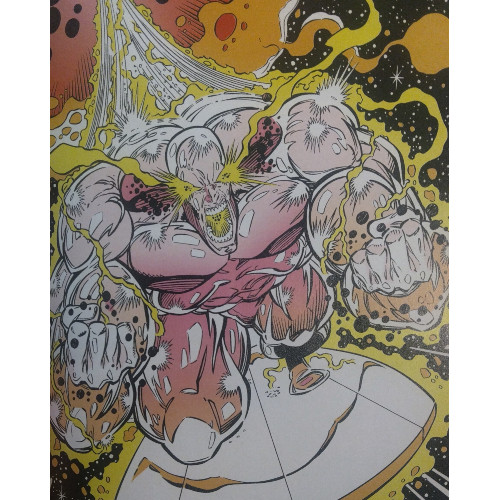
My favorite pop culture icon, Spidey, counted among the brainwashed, plays a minor role during this cascading crusade–in a bittersweet moment, he bludgeons Strong Guy of X-Factor, only to get trounced in return the next page. But Spidey's most interesting moment comes near the end of the saga, during the denouement. Freed from the brainwashing, Spidey notes that this "[m]ust mean the good guys won again." Yep, pat yourself on the back, Spidey…for doing nothing. Our heroes' agency, as a whole, has waned across these "Infinity" events. I can't fault Starlin for setting up Warlock as the hero/savior of these stories, as that seems his primary intent. But as I already noted, I preferred how he handled the character in Infinity Gauntlet, as a messenger/recruiter, the guy who knew the threat and knew what needed to be done and maneuvered plans to work out that way, yet involved our heroes to do so. Here, he's less a manipulator and more a behind-the-scenes worker, and though we get a resolution to his own tale, it comes at the cost of giving our heroes little to do other than either walk around like zombies or talk about what they should be doing.
Thus, the "Infinity Trilogy" comes to a close, not with the glimmering, cleansing light of salvation as the Goddess would have wished it, but with the soft twinkling of a distant star darkened by the sudden appearance of cloud cover. I'd have to debate with myself whether I appreciated War or Crusade less–there are aspects of both to appreciate, but the additional length and complication added to the plots of each prevent both series from coming even close to their oldest brother. Together, all three stories represent a fairly decent "conclusion" to Starlin's ongoing narrative for Warlock (though the creator would return to the character, as we'll hopefully even see in an upcoming "(Strand)om Stories" review or two). Adam is the centerpiece of this whole thing, yet his centrality comes at a cost: with a cast as encompassing as this one, characters are naturally going to be sidelined, even if you tell your tale in sixteen parts. Changes could have been made to help with that; I'd argue we needed way less Pip the Troll and fewer discussions and diatribes. A bit more action, less reiterating of the stakes and theming, more crossing of swords and fighting for self-proclaimed just causes and counter-causes…this is a crusade, after all, isn't it?